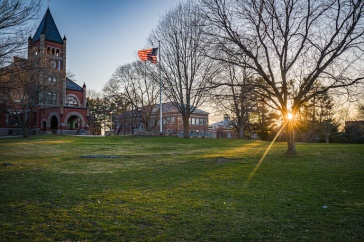
I read that you are an architect. Did that help the story evolve the way it did—through objects rather than words?
RD: Definitely. My architecture and my model making come from the same impulse. I try to limit my time on the computer. I love to work with tactile materials. Louis Kahn got a lot of grief for asking a brick "What do you want, brick?" but if you approach your materials this way, without preconceptions, they always tell you what they do best -- they tell you where their center of gravity is, how far you can stretch them before they bend or break, and how quickly they dry. The scale doesn't really matter; models and architecture have the same considerations of gravity, stability, fasteners and natural light -- I only shoot using natural light.
Also, as an architect, when I design I imagine what it is like to be in the space I am designing for my client, what their experience of the space will be. I do the same thing with the characters in my stories -- I see the world I have made for them through their eyes and grow the story from there.
How did you get the idea for the story?
RD: I start with a single image. In the case of “Hank Finds an Egg” the first image was of Hank holding an egg, wondering what to do with it. The next image I made was Hank discovering the egg. I have never taken pictures in the order in which they appear in the final version because it is through the process of taking pictures, seeing what looks good, seeing what postures make Hank look most alive, and seeing the world through his eyes, that I figure out what will happen next. I never know where stories are going when I start.
Do you think of yourself as a writer, a storyteller or both?
RD: A writer. I write the story by taking pictures and then cobbling them together and then re-shooting them if I need to create continuity. I usually don't know the ending until very late in the process. I have never started with a story and then figured out how to tell the story through pictures.
Have you written other books?
RD: I have two self-published books -- 'Hank Finds an Egg and Makes Several Friends' and 'Li'l Smokey's Special Box', both collections of very short stories. I took them out of print as soon as 'Hank Finds an Egg' was published because I had so much more time to take the pictures for the new book and the self-published books were all shot within a couple weeks, so there's a big difference in terms of quality. I love my self-published books, but I really made them to show agents and publishers that my work could be turned into a book.
Do you see this as your new path, children’s book author?
RD: This is what I am doing, full-time, no question. A couple years ago my work shifted from about 90 percent architecture and 10 percent art to 90 percent art and 10 percent architecture. I will always keep my architectural license, but publishing is a great way to touch people's lives in a meaningful way.
I read an interview that said you made a newspaper when you were young, and that you did dioramas. It sounds like you had a very creative childhood. What fed that?
RD: My parents encouraged a lot of self-directed play, which I loved, and Durham, N.H. was a beautiful place to grow up. As a little kid I used to walk downtown alone (without shoes!) to get candy at Young's, go to movies at the Franklin Theater by myself on school nights, go to the university library, hike through the College Woods, swim at Packers Falls and the pool, visit pigs, sheep, horses, cows and calves at the university barns, wade through the streams that feed Mill Pond, skate on Mill Pond, ride bikes down little roads. Durham is the one place I never use a map because I want to preserve the mystery of those little roads.
Also, my parents let me take any classes I was interested in. I took ceramics, weaving, horseback riding, dance and theater classes. Mom and dad are both great craftspeople -- they made dollhouses, kites and a small hot air balloon. Dad made a car.
They share a strong environmental conscience and were always finding ingenious ways to live "off the grid." We heated the house with wood for decades. Their ingenuity gave me the impression that if I wanted something I could try to make it myself and if I wanted to do something I could do it, even if everyone else was doing something else.
Tell me a little about your path to Hank, and where you think it might lead you?
RD: I have had a few exhibits of my photographs in art galleries, which is flattering, but I really see my work as a series of images made to convey a narrative. It is always a challenge, choosing images to display in a gallery separate from the rest of the images that tell the story. I like making work that anyone can own and books are a great way to do that. I feel good about putting art in the hands of children. And, amidst all the dire publishing news the children's book market is actually growing. So I think there are more picture books in my future.
Originally published by:
UNH Today
-
Written By:
Staff writer | Communications and Public Affairs

















































